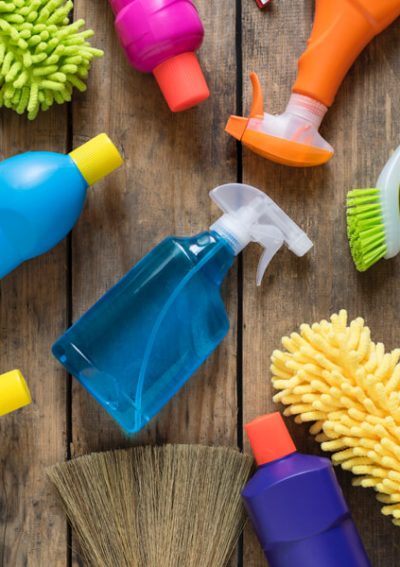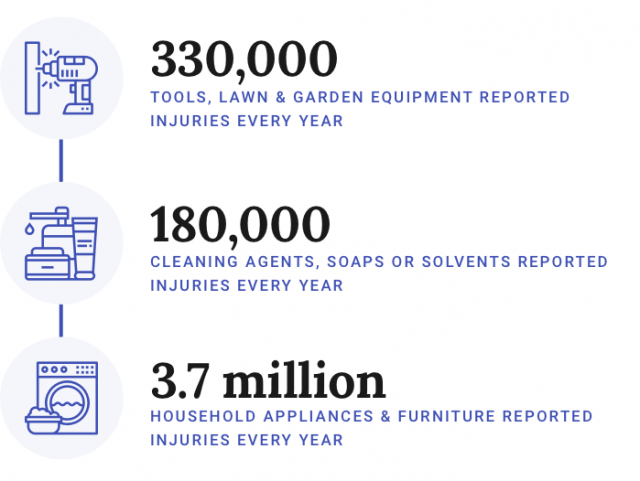Harmful Products
Consumer products include everything we buy. And they are associated with nearly half of all emergency room visits every year. The food we eat, the products we put on our skin, and the items we trust to keep our children safe can also present serious safety hazards. But the Consumer Product Safety Commission and other public-safety agencies offer resources to keep you informed about the products in your home and avenues for reporting dangers you’ve experience with a product.

Americans seek medical attention for 30 to 40 million consumer product-related injuries every year, according to the Consumer Product Safety Commission.
The cost of these injuries is staggering. The United Nations Conference on Trade and Development estimates these injuries cost U.S. consumers $1 trillion a year. That comes to roughly $2,800 for every person in America.
The CPSC gathers most of its information on product-related injuries from hospitals. But consumers can also report injuries they’ve experienced to the agency’s Safer Products webpage.

Product Safety and Recalls
The Consumer Product Safety Act of 1972 established the CPSC and gave it authority to recall or ban products that threaten consumers’ safety.
The commission regulates roughly 15,000 types of consumer products in the United States. It also keeps track of injuries across 88 different groups of products ranging from toys to chainsaws. And those are just the products under the CPSC’s scope. Eight other federal agencies monitor and regulate consumer products from medicines to cars to airplanes.
Certain government agencies may order recalls if a product is unsafe. Or they may work with manufacturers who voluntarily recall a product.
But it isn’t always easy for consumers to know which agency to turn to for recall information. For example, the CPSC oversees nursery equipment and toys, but the National Highway Traffic Safety Administration oversees child car seats. And while the NHTSA oversees motorcycles, the CPSC monitors ATVs, mopeds and minibikes.
If you want to find out whether a product you use is subject to a recall, you can search at Recalls.gov. The federal government combines searches from six different agencies responsible for issuing the most common recalls.
Federal Agencies that Oversee Consumer Product Safety and Recalls
- Consumer Product Safety Commission (CPSC)
- Most consumer goods
- Food and Drug Administration (FDA)
- Cosmetics, Drugs, Electronic device radiation, Food, Medical devices, Tobacco products, Veterinary medicines
- Federal Aviation Administration (FAA)
- Aircraft
- National Highway Traffic Safety Administration (NHTSA)
- Passenger cars, Commercial trucks, Motorcycles, Tires, Child car seats
- Environmental Protection Agency (EPA)
- Pesticides, Fungicides, Other household chemicals
- U.S. Coast Guard
- Boats
In addition to agencies that monitor consumer products, The United States Department of Agriculture regulates food and agricultural products, and the Occupational Safety & Health Administration oversees industrial and business products and farm equipment.

Children’s Products
Defective or poorly designed cribs, car seats and toys all present dangers to children. The CSPC estimates that toys may injure a quarter million kids every year — and that doesn’t include injuries from bicycles, skateboards or sporting equipment.
A 2017 study in the journal Pediatrics estimates nearly six in every 1,000 infants will require an emergency room visit for injuries related to nursery equipment by the age of three. And the CPSC estimates a child is injured every 30 minutes from tipped-over furniture or a falling TV.
Selected Child Safety Risks
- Toys
- About 250,000 toy-related injuries require ER treatment annually. - CSPC
- Nursery Equipment
- Baby carriers, cribs and strollers account for more than half of all nursery product-related injuries. - Pediatrics
- Car Seats
- Between 1997 and 2017, 125 car-seat recalls affected 37 million seats. - NHTSA

Home and Furnishing
The vast majority of consumer product injuries happen in the home. The CPSC estimates that home cleaning or maintenance products or the home’s design itself are related to 9.5 million emergency room visits every year. It stresses the products may not necessarily be the cause of all the injuries.
But risks lurk in every room, across every yard and in every weekend handyman’s tool box.
Home injuries involve falls down stairs and running into glass doors. They also include injuries from tools, lawnmowers, appliances like treadmills, or cleaning products. And nearly 900,000 injuries a year involve beds.
The CPSC’s National Electronic Injury Surveillance System collects data on product-related injuries from hospitals. An NEISS coordinator reviews patient medical records and enters data daily. The information is then analyzed and released to the public on the CPSC website.
Select Home Product-Related Injuries Reported to CPSC Every Year

Household Products
The American Lung Association warns that many household products may lead to conditions including asthma and cancer. These products include aerosol sprays, cleaning supplies and even air fresheners. It can be hard to determine the risks posed by specific products because United States law does not require manufacturers to list all the chemicals in household products. Improper disposal can pollute drinking water or contribute to indoor air pollution in the home.

Personal Care
The National Institutes of Health estimates that the average woman in the United States uses 12 personal care products daily. Men average six products every day. But few people realize the ingredients in these trusted products may cause health problems.
In 2016, California public health researchers reported that at least 13 types of personal care products — from cosmetics to shaving and baby products — may contain ingredients that have serious health consequences. These included substances that may cause reproductive complications and cancer.
Dangers of Personal Care Products
- Talcum Powder (FDA)
- The International Agency for Research on Cancer classifies talc use on the genitals as “possibly carcinogenic to humans.” And multiple studies have suggested a 30 percent increased risk of ovarian cancer with talc use.
- Cosmetics (FDA)
- Tens of thousands of possible cosmetic injuries occur every year. A 2017 study found serious underreporting of cosmetic side effects to the FDA.

Technology
The most common injuries from consumer technology products stem from how we use devices. People can twist themselves into unnatural positions to stare at their screens or tap out text. These injuries include creative names such as selfie elbow, tech neck, or texting thumb. While these injuries may sound minor, some people need physical therapy to get over them.
In rare cases, batteries that power your personal tech can explode, cause fires and seriously burn you or other people. Lithium ion batteries are favored to power laptops, cell phones and other tech products because of their long-lasting power. But battery fires have led to recalls of cell phones and hoverboards.
And the U.S. Fire Administration called the combination of lithium ion batteries with electronic cigarettes, or e-cigs, “a new and unique hazard.” The devices combine health risks with serious explosion dangers.
Injuries and Risks Related to Technology Products
- Tech-Use Injuries
- Medical company ImagineMD reported that “thumb pain” is the most often searched tech-related injury, with 10,000 Google searches a month.
- Lithium Batteries & Devices
- The Federal Aviation Administration reported 225 incidents of fires involving lithium batteries in baggage or as cargo in aircraft or airports between 1991 and 2018.
- E-Cigarettes (FDA)
- E-cig explosions and fire resulted in 133 cases of acute injury between 2009 and 2016.
61 Cited Research Articles
Consumernotice.org adheres to the highest ethical standards for content production and references only credible sources of information, including government reports, interviews with experts, highly regarded nonprofit organizations, peer-reviewed journals, court records and academic organizations. You can learn more about our dedication to relevance, accuracy and transparency by reading our editorial policy.
- Agency for Toxic Substances & Disease Registry. (2003, September). Toxic Substances Portal — Malathion. Retrieved from https://wwwn.cdc.gov/TSP/PHS/PHS.aspx?phsid=520&toxid=92
- Bellon, T. (2018, July 11). Lawsuits Against Monsanto’s Roundup Cleared for Trial. Retrieved from https://www.insurancejournal.com/news/national/2018/07/11/494711.htm
- California Department of Public Health. (2016, August). Cosmetics Containing Ingredients Linked to Cancer or Reproductive Harm; Data Reported to the California Safe Cosmetics Program 2009-2015. Retrieved from https://www.cdph.ca.gov/Programs/CCDPHP/DEODC/OHB/CSCP/CDPH%20Document%20Library/DataReport.pdf
- California Office of Environmental Health Hazard Assessment. (2017, July 7). Glyphosate Listed Effective July 7, 2017 as Known to the State of California to Cause Cancer. Retrieved from https://oehha.ca.gov/proposition-65/crnr/glyphosate-listed-effective-july-7-2017-known-state-california-cause-cancer
- CBS News. (2018, August 15). Weed-killing chemical linked to cancer found in some children’s breakfast foods. Retrieved from https://www.cbsnews.com/news/glyphosate-roundup-chemical-found-in-childrens-breakfast-foods/
- Center for Biological Diversity. (2018, May 30). Lawsuit Seeks to Force EPA to Curb Risks from Dangerous Pesticide Malathion. Retrieved from https://www.biologicaldiversity.org/news/press_releases/2018/malathion-05-30-2018.php
- Center for Environmental Health, Center for Biological Diversity, and Californians for Pesticide Reform v. E. Scott Pruitt, United States Environmental Protection Agency, United States Fish and Wildlife Service and Ryan Zinke. (2018, May 30). Complaint for Declaratory and Injunctive Relief. Retrieved from https://www.biologicaldiversity.org/campaigns/pesticides_reduction/pdfs/2018-5-30-Malathion-Complaint.pdf
- Centers for Disease Control and Prevention. (2018, April 4). CDC and Food Safety. Retrieved from https://www.cdc.gov/foodsafety/cdc-and-food-safety.html
- Centers for Disease Control and Prevention. (2018, September 4). Child Passenger Safety. Vital Signs. Retrieved from https://www.cdc.gov/vitalsigns/childpassengersafety/index.html
- Charles, D. (2018, November 1). The EPA Says Farmers Can Keep Using Weedkiller Blamed For Vast Crop Damage. Retrieved from https://www.npr.org/sections/thesalt/2018/11/01/662918255/the-epa-says-farmers-can-keep-using-weedkiller-blamed-for-vast-crop-damage
- Consumer Product Safety Commission. (2011, August 12). Consumer Product Safety Act. Retrieved from https://www.cpsc.gov/PageFiles/105435/cpsa.pdf?epslanguage=en
- Consumer Product Safety Commission. (December 31, 2017). NEISS Data Highlights – 2017. Retrieved from https://www.cpsc.gov/s3fs-public/2017-Neiss-data-highlights.pdf
- Consumer Product Safety Commission. (n.d.). National Electronic Injury Surveillance System (NEISS). Retrieved from https://www.cpsc.gov/Research--Statistics/NEISS-Injury-Data/
- Consumer Product Safety Commission. (n.d.). Products Under the Jurisdiction of Other Federal Agencies and Federal Links. Retrieved from https://www.cpsc.gov/Regulations-Laws--Standards/Products-Outside-CPSCs-Jurisdiction
- Consumer Product Safety Commission. (n.d.). SaferProducts.gov. Retrieved from https://www.saferproducts.gov/
- Cornell University Extension Toxicology Network. (1993, September). Dicamba. Retrieved from http://pmep.cce.cornell.edu/profiles/extoxnet/carbaryl-dicrotophos/dicamba-ext.html
- Environmental Protection Agency. (2014). Reusing Potentially Contaminated Landscapes: Growing Gardens in Urban Soils. Retrieved from https://www.epa.gov/sites/production/files/2014-03/documents/urban_gardening_fina_fact_sheet.pdf
- Environmental Protection Agency. (n.d.). Learn About Volkswagen Violations. Retrieved from https://www.epa.gov/vw/learn-about-volkswagen-violations
- Federal Aviation Administration. (2018, August 2). Lithium Batteries & Lithium Battery-Powered Devices. Retrieved from https://www.faa.gov/hazmat/resources/lithium_batteries/media/Battery_incident_chart.pdf
- Federal Emergency Management Agency. (2017, July). Electronic Cigarette Fires and Explosions in the United States 2009 – 2016. U.S. Fire Administration. Retrieved from https://www.usfa.fema.gov/downloads/pdf/publications/electronic_cigarettes.pdf
- Gaw, C.E., Chounthirath, T., and Smith, G.A. (2017, April). Nursery Product-Related Injuries Treated in United Sates Emergency Departments. Pediatrics. Retrieved from https://pediatrics.aappublications.org/content/pediatrics/139/4/e20162503.full.pdf
- Gillam, C. (2018, August 11). One man’s suffering exposed Monsanto’s secrets to the world. Retrieved from https://www.theguardian.com/business/2018/aug/11/one-mans-suffering-exposed-monsantos-secrets-to-the-world
- Gillam, C. (2018, May 8). Weedkiller products more toxic than their active ingredient, tests show. Retrieved from https://www.theguardian.com/us-news/2018/may/08/weedkiller-tests-monsanto-health-dangers-active-ingredient
- Gorzelany, J. (2018, March 13). Auto Recalls Hit a Four-Year Low Last Year, But Still Exceed Units Sold. Retrieved from https://www.forbes.com/sites/jimgorzelany/2018/03/13/auto-recalls-hit-a-four-year-low-last-year-still-exceed-units-sold/#5ec348738567
- Hakim, D. (2017, September 21). Monsanto’s Weed Killed, Dicamba, Divides Farmers. Retrieved from https://www.nytimes.com/2017/09/21/business/monsanto-dicamba-weed-killer.html
- Jolly, J. (2018, April 3). Tech Neck, Texting Thumb: Our Bad Tech Habits Leave Us in Pain. Here’s How to Feel Better. USA Today. Retrieved from https://www.usatoday.com/story/tech/columnist/2018/04/03/tech-neck-texting-thumb-top-bad-tech-habits-and-how-fix-them/443637002/
- Kwa, M., Welty, L.J., and Xu, S. (2017, June 26). Adverse Events Reported to the U.S. Food and Drug Administration for Cosmetics and Personal Care Products. Retrieved from https://jamanetwork.com/journals/jamainternalmedicine/fullarticle/2633256
- Lawrence, B.A., Spicer, R.S., and Miller, T.R. (2014, August 1). A Fresh Look at the Costs of Non-Fatal Consumer Product Injuries. Retrieved from https://injuryprevention.bmj.com/content/injuryprev/21/1/23.full.pdf
- Lucas, A. (2018, July 30). From Ritz Crackers to McDonald’s Salads, Food Recalls – and Safety Questions – are on the rise. CNBC. Retrieved from: https://www.cnbc.com/2018/07/27/food-recalls-are-increasing-but-that-doesnt-mean-your-food-is-unsafe.html
- Moynihan, T. (2017, March 19). Don’t Blame the Batteries for Every Lithium-Ion Explosion. Retrieved from https://www.wired.com/2017/03/dont-blame-batteries-every-lithium-ion-explosion/
- National Capital Poison Center. (n.d.). Batteries Cause Devastating Injuries. Retrieved from https://www.poison.org/articles/button-batteries
- National Highway Traffic Safety Administration. (2015, February). Critical Reasons for Crashes Investigated in the National Motor Vehicle Crash Causation Survey. Traffic Safety Facts. Retrieved from https://crashstats.nhtsa.dot.gov/Api/Public/ViewPublication/812115
- National Highway Traffic Safety Administration. (2018, January 18). 2017 Annual Recall Report. Retrieved from https://www.nhtsa.gov/sites/nhtsa.dot.gov/files/documents/2017_recall_annual_report_updated011818_0.pdf
- National Highway Traffic Safety Administration. (n.d.). Car Seats and Booster Seats. Retrieved from https://www.nhtsa.gov/equipment/car-seats-and-booster-seats
- National Highway Traffic Safety Administration. (n.d.). Vehicle Recalls: Frequently Asked Questions. Retrieved from https://vinrcl.safercar.gov/vin/faq.jsp
- National Institutes of Health. (2014, September 14). Chemicals in Personal Care Products. Partnerships for Environmental Public Health (PEPH) Podcast. Retrieved from https://www.niehs.nih.gov/research/supported/translational/peph/podcasts/2014/sept14_consumer-health/index.cfm
- National Pesticide Information Center. (2018, August 29). Safe Use Practices for Pesticides. Retrieved from http://npic.orst.edu/health/safeuse.html
- National Pesticide Information Center. (2019, May). Malathion. Retrieved from http://npic.orst.edu/factsheets/malagen.html
- Nickel, R. (2017, August 2). Drifting crop chemicals deal ‘double whammy’ to farmers. Retrieved from https://www.reuters.com/article/us-usa-pesticides-farmers/drifting-crop-chemical-deals-double-whammy-to-u-s-farmers-idUSKBN1AI1I2
- Pet Poison Helpline. (n.d.). 23/7 Animal Poison Control Center. Retrieved from https://www.petpoisonhelpline.com/
- Recalls.gov. (n.d.). Search Recalls from All Agencies. Retrieved from https://www.recalls.gov/search.html
- Robinson, M. (2014, September/October). Reporting Product-Related Injuries and Deaths to the U.S. Consumer Product Safety Commission (CPSC). AAEM News. Retrieved from https://www.aaem.org/UserFiles/SepOct14CPSC.pdf
- Salama, M. et al. (2015, December). Developmental neurotoxic effects of Malathion on 3D neurosphere system. Retrieved from https://www.ncbi.nlm.nih.gov/pmc/articles/PMC4803784/
- Schroder, T. (2012, February). Consumer Product-Related Injuries and Deaths in the United States: Estimated Injuries Occurring in 2010 and Estimated Deaths Occurring in 2008. Retrieved from https://www.cpsc.gov/PageFiles/134720/2010injury.pdf
- Shepardson, D. (2018, July 9). U.S. appeals court upholds Volkswagen’s $10 billion diesel settlement. Retrieved from https://www.reuters.com/article/us-volkswagen-emissions/u-s-appeals-court-upholds-volkswagens-10-billion-diesel-settlement-idUSKBN1JZ21G
- Steenhuysen, J. (2016, February 24). Evidence on Talc Cancer Risk Differs for Jurors, Researchers. Reuters/Scientific American. https://www.scientificamerican.com/article/evidence-on-talc-cancer-risk-differs-for-jurors-researchers/
- Stericycle Expert Solutions. (2018, February 6). Reflections on Recalls: Five Years of the Stericycle Expert Solutions Recall Index. News Release. Retrieved from https://www.prnewswire.com/news-releases/reflections-on-recalls-five-years-of-the-stericycle-expert-solutions-recall-index-300594063.html
- Tarazona, J. et al. (2017). Glyphosate toxicity and carcinogenicity; a review of the scientific basis of the European Union assessment and its differences with IARC. Retrieved from https://www.ncbi.nlm.nih.gov/pmc/articles/PMC5515989/
- Temkin, A. (2018, August 15). Breakfast With a Dose of Roundup? Weed Killer in $289 Million Cancer Verdict Found in Oat Cereal and Granola Bars. Retrieved from https://www.ewg.org/research/breakfast-dose-roundup
- Tselepidakis, Elina. (2018, April). Trends in Food Recalls: 2004-13. Retrieved from https://www.ers.usda.gov/webdocs/publications/88497/eib-191.pdf
- Tsukayama, H. (2016, July 5). “Selfie Elbow” Is the Latest in a Long Line of Tech-Related Injuries. Retrieved from https://www.washingtonpost.com/news/the-switch/wp/2016/07/05/selfie-elbow-is-the-latest-in-a-long-line-of-tech-related-injuries/
- Tu, Y. (2017, October 24). Toy-Related Deaths and Injuries Calendar Year 2016. Retrieved from https://www.cpsc.gov/s3fs-public/Toy_Report_2016.pdf?6ZwpKyiwsEdVzWXhH0m0doo5cJALIZFW
- U.S. Consumer Product Safety Commission. (n.d.). Anchor It! Retrieved from https://www.anchorit.gov/
- U.S. Consumer Product Safety Commission. (n.d.). National Electronic Injury Surveillance System (NEISS). Retrieved from https://www.cpsc.gov/Research--Statistics/NEISS-Injury-Data/
- U.S. Food and Drug Administration. (2018, September 4). Melamine Pet Food Recall of 2007. Retrieved from https://www.fda.gov/animal-veterinary/recalls-withdrawals/melamine-pet-food-recall-2007
- United Nations Conference on Trade and Development. (2018, July 11). Unsafe Consumer Products Cost U.S. Economy $1 Trillion Each Year. Retrieved from https://unctad.org/news/unsafe-consumer-products-cost-us-economy-1-trillion-each-year
- Wolf, L.L. et al. (2017, May 18). Factors Associated with Pediatric Mortality from Motor Vehicle Crashes in the United States: A State-Based Analysis. The Journal of Pediatrics. Retrieved from https://www.jpeds.com/pb/assets/raw/Health%20Advance/journals/ympd/9153Wolf.pdf
- World Health Organization. (1999). Contaminated Soil in Gardens: How to avoid the harmful effects. Retrieved from http://www.euro.who.int/__data/assets/pdf_file/0009/119187/E64737.pdf
- World Health Organization. (2010). Exposure to Highly Hazardous Pesticides: A Major Public Health Concern. Retrieved from https://www.who.int/ipcs/features/hazardous_pesticides.pdf?ua=1
- World Health Organization. (n.d.). Pesticide residues in food. Retrieved from https://www.who.int/news-room/fact-sheets/detail/pesticide-residues-in-food
- Zaveri, M. (2018, August 15). Report Finds Traces of a Controversial Herbicide in Cheerios and Quaker Oats. Retrieved from https://www.nytimes.com/2018/08/15/health/herbicide-glyphosate-cereal-oatmeal-children.html
Calling this number connects you with a Consumer Notice, LLC representative. We will direct you to one of our trusted legal partners for a free case review.
Consumer Notice, LLC's trusted legal partners support the organization's mission to keep people safe from dangerous drugs and medical devices. For more information, visit our partners page.
844-420-1914
